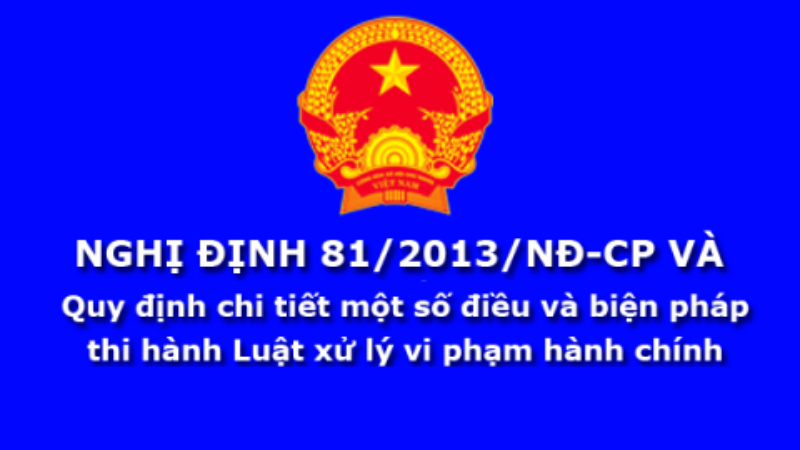The administrative penalty procedure is a complex process that can be challenging to navigate for those unfamiliar with it. This guide aims to provide a comprehensive understanding of the sequence and procedures for addressing administrative violation penalties.
1. Understanding the Legal Framework for Administrative Violation Procedures
The National Assembly’s Law No. 15/2012/QH13: Law on Handling Administrative Violations, specifically in “Chapter III, Section 1 – Procedure for Handling Administrative Violations”, outlines the legal provisions for addressing administrative violations. Articles 55 to 68 provide detailed content, including notable aspects such as enforcing the termination of administrative violations, handling them with or without establishing records, and the necessary dossiers.
 Law No. 15/2012/QH13: Law on Handling Administrative Violations
Law No. 15/2012/QH13: Law on Handling Administrative Violations
2. A Step-by-Step Guide to Handling Administrative Violations
Procedure Overview
The process of handling administrative violations typically encompasses the following stages:
Step 1: Initiating the Penalty
When an agency or authorized individual identifies an administrative violation within their field of management, they are obligated to take action. This involves either forcing the subject to immediately cease the violation or transferring the case to a competent authority to address it effectively.
 Initiating Penalties for Administrative Violations
Initiating Penalties for Administrative Violations
Step 2: Inspection and Examination
This stage is crucial as it determines whether an act is right or wrong. It involves several key steps, including inspection and verification minutes, working minutes (depending on the context), and, if necessary, minutes of administrative violations.
Note: Minute templates must adhere to Template No. 01, issued alongside Decree No. 97/2017/ND-CP dated August 18, 2017. The establishment of minutes should follow Article 58 of the 2012 Law on Administrative Sanctions.
The minutes of administrative violations should encompass essential details such as the date, time, and location of the minute’s establishment; the full name and position of the person creating the minutes; information about the violator or violating organization; details of the violation; and statements from involved parties, including witnesses, victims, or their representatives.
 Inspection and Examination of Administrative Violations
Inspection and Examination of Administrative Violations
In cases where the violator or their representative is absent, evasive, or unable to sign the minutes for objective reasons, the signature of a local government representative or two witnesses is required.
Once the minutes are completed, provide a copy to the violating organization or individual. If the violator is a minor, ensure that the minutes are also sent to their parents or legal guardian, as mandated.
If the administrative violation falls outside the competent authority’s scope or exceeds their penalty authority, immediately transfer the minutes to the appropriate entity to handle the penalty.
Step 3: Verifying Case Circumstances
During the consideration of an administrative violation sanction decision, the authorized person may need to verify various circumstances. These include determining the presence of an administrative violation, identifying the individuals or organizations involved, assessing aggravating and mitigating factors, evaluating the nature and extent of damage caused, and considering other relevant factors that may impact the decision-making process.
 Verifying Case Circumstances
Verifying Case Circumstances
The authorized person may request an appraisal during the decision-making process, adhering to the law on appraisals. Additionally, the verification of case circumstances must be documented in writing.
Step 4: Determining the Value of Exhibits
If necessary, determining the value of exhibits related to the administrative violation can provide a foundation for calculating penalty amounts and establishing sanctioning authority. However, it’s important to note that the time limit for temporarily holding exhibits should not exceed 24 hours from the decision, with possible extensions if required.
 Determining the Value of Exhibits
Determining the Value of Exhibits
Step 5: Right to Explanation
Individuals or organizations facing administrative violations have the right to provide explanations or authorize their lawful representatives to do so in writing. These explanations must be submitted to the authorized agency or person within no more than 05 days from the establishment of the administrative violation minutes.
 Right to Explanation in Writing
Right to Explanation in Writing
Step 6: Issuing the Sanction Decision
If the violation act indicates criminal activity, transfer the violation dossier to the appropriate authorities. If there are no signs of a crime and no criminal prosecution is pursued, proceed to issue a decision to sanction the administrative violation. This involves sending, transferring, and announcing the decision to the violating agency, organization, or individual, and then executing the sanction as specified in the decision.
 Issuing the Sanction Decision
Issuing the Sanction Decision
Regulations on Handling Administrative Violations
The regulations governing the handling of administrative violations are outlined in Decree 81/2013/ND-CP dated July 19, 2013. Chapter 1 of this decree provides detailed provisions on sanctioning administrative violations and applying administrative handling measures, as stipulated in Articles 1 to 18.
The decree covers various aspects, including the object of administrative violation sanctions, definitions of administrative violation acts, forms of sanctions and their levels, and measures to address the consequences in the field of state management.
 Decree 81/2013/ND-CP dated July 19, 2013
Decree 81/2013/ND-CP dated July 19, 2013
3. Handling Administrative Violations in Specific Cases
Case: Handling Administrative Violations Without Establishing Minutes
In situations where a warning is issued or a fine imposed on an individual does not exceed VND 250,000, or VND 500,000 for an organization, the authorized person must issue an on-the-spot sanction decision. However, if the violation is detected using technical equipment or means, establishing minutes is mandatory.
The on-the-spot sanction decision should include critical details such as the decision date and year, information about the violator or violating organization, the violating act, location, evidence, and related circumstances. If a fine is imposed, the amount must be stated in the decision.
 Administrative Violation Case Without Minutes, Sanctioned with a Warning or Fine
Administrative Violation Case Without Minutes, Sanctioned with a Warning or Fine
Case: Handling Administrative Violations with Minutes and Dossiers
When the violating subjects’ acts do not fall under the cases prescribed for handling without minutes, the process involves establishing minutes and dossiers. The authorized person responsible for sanctioning must create a dossier that includes the minutes of administrative violations, the sanction decision, and related documents, ensuring pagination and proper archiving according to archival laws.
 Handling Administrative Violations with Minutes and Dossiers
Handling Administrative Violations with Minutes and Dossiers
4. New Developments in Administrative Violation Procedures
The latest regulations introduce several new points to the procedure for handling administrative violations. These updates aim to facilitate easier identification of violating acts and enhance their deterrent effect while maintaining democratic principles. Specifically, the National Assembly’s amended Law on Handling Administrative Violations includes provisions for sanctioning individuals who commit multiple or repeated administrative violations, as outlined in Clause 2, Article 1 of the amended and supplemented Law No. 67.
You may also like:
Unraveling the Guilt Trip: Spotting Signs and Strategies
Get equipped with essential knowledge to navigate the intricate world of traffic accident procedures. This guide will empower you to handle post-accident protocols with ease, covering everything from understanding your rights to taking crucial steps in unforeseen circumstances.


































